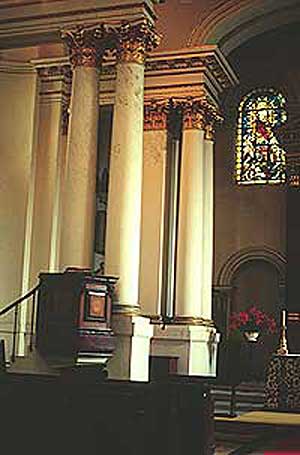
How Do Visual Arts Shape Spiritual Life?
Building Anglican Liturgy

Photo courtesy of the author
St. Mary Woolnoth
![]()
Building Anglican Liturgy
Response: Giving
Form to Anglican Liturgy in the City Churches of London
John W. Dixon, Jr.
The story of the "City Churches" can be quickly told. (For the benefit of those not familiar with the term, "the City" is London proper, the central district of what we know as London. Suburban towns grew up around this city of London and coalesced into the whole as we now know it. Gradually, the people moved away from the City, which became London's thriving financial and business center. This is a major problem for the church and the city: what do you do with a large number of parish churches when there are no longer any people in the parish?)
The central event of the story is the great fire of 1666. London had been well supplied with parish churches (something like 89) but a large proportion was destroyed or heavily damaged in the fire. Rebuilding homes and shops could be left to individuals and the development went on rather higgledy-piggledy. Public buildings were another matter and there were few capable architects available. It was the great good fortune of the church that the rebuilding was given to the hero of this story, Christopher Wren.
Not the least of the merits of these two books is that they do not treat this rebuilding project as a matter of abstract architectural design but describe briefly and vividly the realities of such an enterprise. The whole affair had to be worked out under the conditions of personalities, often cranky and quarrelsome, of specific problems, of finance, siting, the myriad decisions that had to be made. Since not all were rebuilt; imagine the wrangling over which would be rebuilt, which would be combined with other parishes.
In the end 51 were rebuilt. At one time Wren was given credit for designing all of these, a task of a magnitude beyond the time and energies of one man, particularly given that he had responsibilities other than churches. While he had general supervision of the whole project, many churches were designed by his assistants, the greatest of whom was Nicholas Hawksmoor. While it is impossible to sort the credit, Wren seems to have had whole or chief responsibility for as many as 29, still a major achievement. The difficult problem of attribution is summarized in Jeffrey's account of Wren's work on churches.
Over the years, many of these churches have disappeared, some have been completely rebuilt after other catastrophic fires (including those of World War II), and all have to one degree or another been affected by remodeling. Some twenty or more survive. All are of interest, some are fine work and two are major masterpieces, Wren's St. Stephen Walbrook and Hawksmoor's St. Mary Woolnoth. (Some add Wren's St. Mary-le-Bow). By general agreement, the finest is St. Stephen, one of the greatest buildings in England. Taken together, the City Churches constitute a kind of laboratory of what constitutes a specifically Anglican church.
For Wren it was not a matter of costuming or of designing a church to produce a certain emotional affect. He wanted to design churches to perform a clear and specific function, which was to serve the liturgy to be enacted within it.
